This article is more than 5 years old.
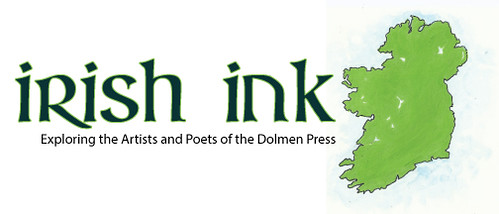
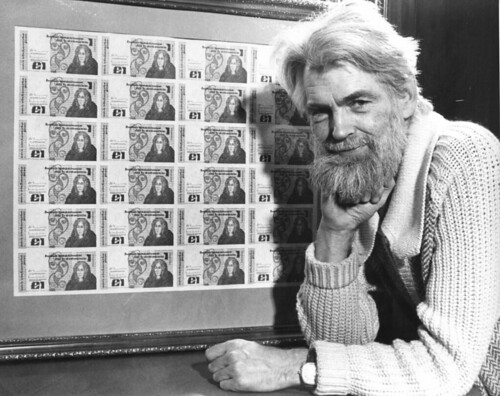
Michael Biggs is best known in Ireland as a Liturgical artist, who carved inscriptions, sculpture and church furnishings. He began his career cutting gravestones and actually continued doing this throughout his life.
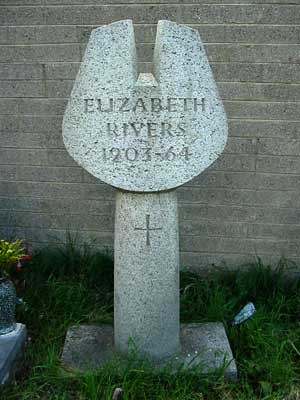
Biggs eventually carved some of the most important Irish memorials honoring her heroes, including the Memorial Wall at Arbour Hill Cemetery, burial place of the leading members of the 1916 Rising, who were executed.
Biggs was born on August 28,1928 in Stockport, Cheshire, England. His father, Claude, was a pianist and organist who moved the family to Ireland when Michael was two years old. Bigg’s mother, Marjorie, was a talented needlepointer. An acquaintance of Bigg’s father, Evan Gill (brother of Eric Gill) was the connection for Michael Biggs to an artists’ community in Ditchling, Sussex founded by Gill. Ultimately, Eric Gill, the well-known printmaker and type designer(Gill Sans, Aries, Perpetua), became an important influence for Biggs and his work.
In school in Ireland, Michael won a music scholarship to St. Columba’s College. He attended Trinity College on a Sizarship (a competitive scholarship). In 1946, Biggs was drafted into the British Army because he was born in England. Following service, Biggs randomly found a book on lettering and decided to become a stone carver. He immediately moved to Ditchling to study lettering with Eric Gill, where Gill and his followers wanted to have a self sufficient community of craftsmen. By the time Biggs arrived in Ditchling, Gill had passed away, but he was able to study under Gill’s apprentice, Joseph Cribb.
Biggs’s first job was carving a memorial plaque to honor a donor of the New Moyne Institute at Trinity College. In 1953, Michael Biggs met and married Frances Dooley, a violinist with the symphony. The Biggs worked together for a time on lettering projects and Frances designed stained glass and tapestry. Biggs soon began to receive commissions from various churches: sanctuary furnishings, metalwork and eventually stone sculpture. Biggs had a special workshop built where he could work separately on lettering and sculpture.
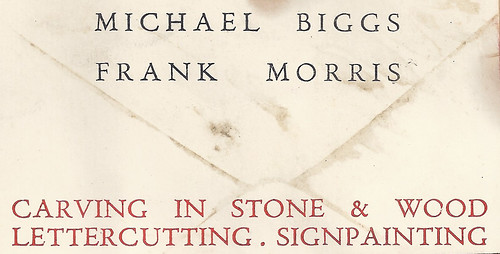
From 1968-1974, Biggs took on assistant Tom Glendon. At this time, there were many new churches being built and this gave Biggs’ workshop the opportunity to make altars and other stone carvings. This stone carving and lettering is the work Biggs is well-known for in Ireland.
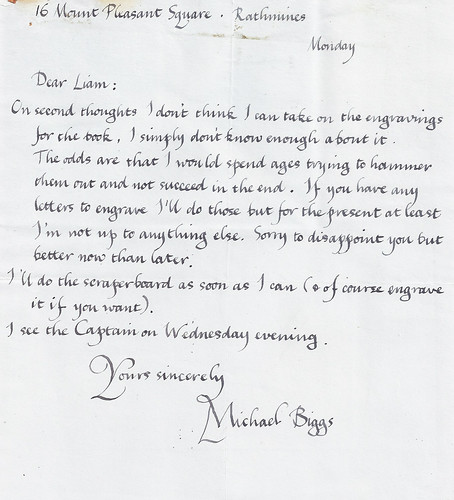
Biggs friendship with Liam Miller provided the opportunity for graphic designs for the printed books of the Dolmen Press, and also connected Miller with many in Biggs’s artist circle.
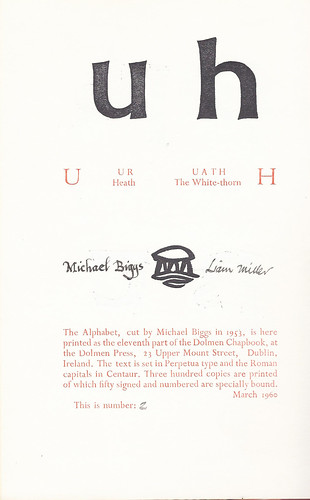
One of Biggs’s most important contributions to the Dolmen Press was A Gaelic Alphabet, written with Liam Miller. This work, initiated by Miller, commissioned Michael Biggs to cut the 18 unique letters used in the Irish (Gaelic) alphabet. The original wooden letters cut by Biggs reside in Special Collections and Archives in the ZSR Library at Wake Forest University.

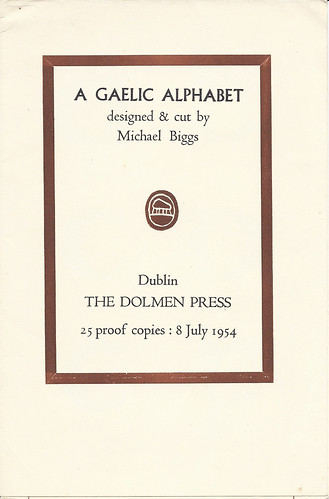
The other Dolmen Press publications that Biggs contributed to were:
- The Midnight Court by Brian Merriman (1953) translated from the Irish by David Marcus – Biggs designed a series of linocuts for this title.
- The Nativity from the Holy Gospel According to St. Luke (1953) – Biggs created a wood engraving for the frontispiece based on his own family nativity.
- Faeth Fiadha (1957) – Biggs hand-lettered 10 special copies.
- The Bird that Flew Away by Gudrun Tempel (1958) – Biggs created linocuts for this title.
In 1972, Servicon, a firm Michael Biggs was affiliated with won a competition for designing new Irish bank notes. Biggs designed an original typeface for the notes based on Irish letter forms.
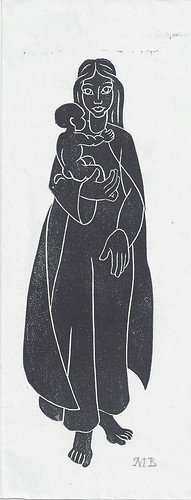
Biggs was elected to Aosdana by his peers in 1989. Aosdana is an Irish arts-based organization to which one must be nominated and elected by peer artists and craftsman. Membership in Aosdana is limited to 250 living artists who have produced a distinguished body of work.
His countrymen more strongly remember Michael Biggs’s stone work, than his graphic designs. Across Ireland, in churches, convents, graveyards and public memorials is the stone work and lettering of Michael Biggs. Biggs designed and carved gravestones for Dolmen artist Elizabeth Rivers and poet Padriac Colum. In a list compiled by Biggs, he lists approximately 40 stone carvings dating from 1978-1980. Some of his key inscriptions in stone are:
- 1959-63 – Arbour Hill Memorial – Biggs hand-carved the entire text of the 1916 Proclamation of Independence into the wall and the names on the graves of the men killed during the Easter Rising of 1916.
- 1966 – Phoenix Park Garda Memorial
- 1967-68 – John F. Kennedy Memorial Park – Biggs designed a granite fountain with inscriptions
- 1980 – Parnell Square Garden of Remembrance, Dublin – Biggs hand-carved the name wall
Michael Biggs has a record in the National Irish Visual Arts Library.
Michael Biggs became ill in the 1990’s with a rare disease which affected the use of his hands and thus his ability to work. He died at the young age of 65 in 1993 and is buried at St. Patrick’s Church, Enniskerry.
Works Consulted
- Biggs, Michael. (1960). A Gaelic Alphabet. Dublin: Dolmen Press.
- Biggs, Michael. (1953) The Nativity from the Holy Gospel According to St. Luke. Dublin: Dolmen Press.
- Merriman, Brian. (1953) The Midnight Court. Dublin: Dolmen Press.
- Miller, Liam. (1960) Ireland’s ABC’s. Ireland of the Welcomes. Jan/Feb. 1960, v.8,n.5,p. 17-20.
- Tempel, Gudrun. (1958) The Bird That Flew Away. Dublin: Dolmen Press.
- Wallace, Arminta. Taking Note of Our Newly Minted Money. Irish Times, Oct. 20, 1977, p.59.
- Whelan, Daphne. Michael Biggs-A Life in Letters and Stones.” Thesis. National College of Art and Design, 1996. Print.

5 Comments on ‘Michael Biggs, Lettering Artist on Paper and Stone’
What a variety of designed things – money, gravestones, and books?! Great write-up, Craig!
“Money Gravestone, and the Books” would be my vote for Biggs’ Irish punk band name (featuring C. Fansler on scratch).
What a cool job, to design typefaces. Its a lost art. Thanks for including visual representations of his work!
What a fun read!
Thanks, Craig!